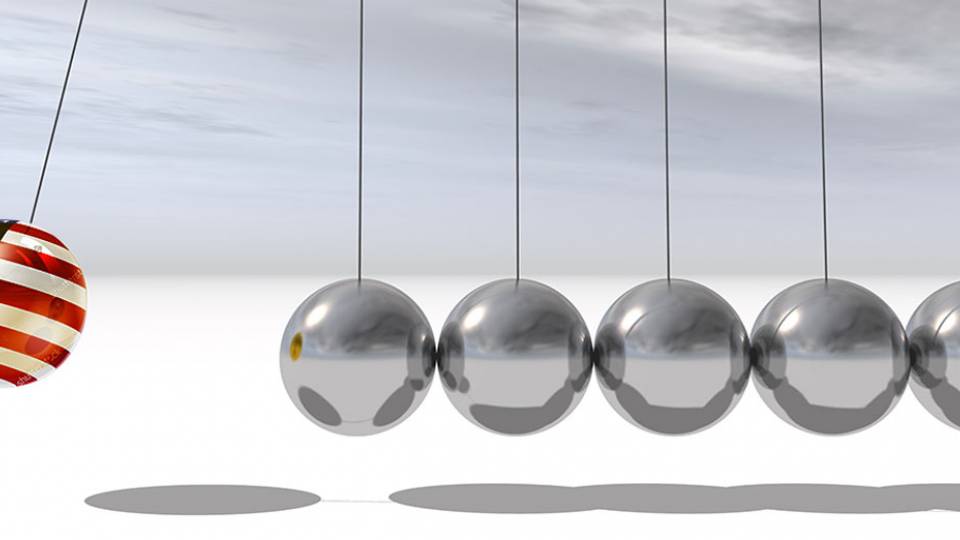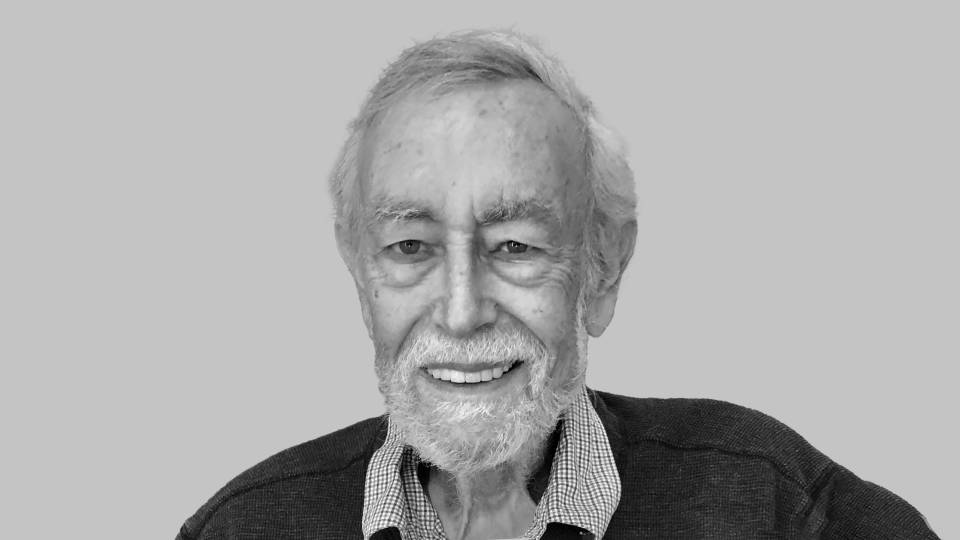From the Nov. 6, 2006, Princeton Weekly Bulletin(Link is external)
Nasty clashes on hot topics such as the Iraq war, social issues and
corruption may dominate the current political discourse, but the answer
to why America is so polarized ultimately lies in the widening gulf
between its richest and poorest citizens.
That is the message of “Polarized America: The Dance of Ideology and Unequal Riches,” written by Princeton’s Nolan McCarty(Link is external), a Congressional and presidential scholar, and two colleagues. The book, which has been cited as a breakthrough in the study of America’s bitterly divided political environment, shows that growing income disparities and increasing immigration levels have driven the current and previous periods of polarization. As Republicans and Democrats have locked horns in promoting policies catering to their core constituents, they have, in turn, exacerbated the divisions between America’s economic classes.
“The consequences of polarization that a lot of scholars have focused on have primarily been the tone and the tenor of politics. But this book focuses a lot more on how it has affected economic policy,” said McCarty, a professor of politics and public affairs and associate dean of the Woodrow Wilson School of Public and International Affairs. “In a more polarized environment, it is much more difficult for political coalitions to form and to pass new legislation and adapt to changing economic and social circumstances.
“The main effect has been a lack of government response to problems. You can identify current issues such as the lack of health care reform, the inability of the minimum wage to keep up with inflation and the deterioration in several other social benefits,” McCarty said. “The main consequences for policy are either that serious problems go unaddressed or the solutions tend to be ideological and one-sided.”
McCarty wrote “Polarized America,” which was published in June, along with Keith Poole of the University of California-San Diego and Howard Rosenthal, a former Princeton professor now at New York University. McCarty began working with Poole and Rosenthal as a doctoral student at Carnegie Mellon University in the 1990s. He is now using the book with his own students as the basis for a new freshman seminar on political polarization.
McCarty and his colleagues examined all Congressional voting records, along with census and public opinion data, to chart periods of polarization throughout American history and to identify their underlying causes. The book debunks a common refrain of political pundits that America’s political divisions have never been as stark as they are today.
“We can put to rest the notion that the country has never been this polarized,” McCarty said. “In other periods of time, especially after Reconstruction in what we call the ‘Gilded Age,’ the parties were just as divergent, and partisanship was just as important. You can identify many similarities between the 1890s and the current period, and the very high levels of economic inequality are among the most important.”
Anne-Marie Slaughter, dean of the Wilson School, said the book’s “overall message is very important, in terms of the connections between inequality and polarization. These are two issues that concern many people independently, and what Nolan and his colleagues have done is to help see how they’re linked in ways that are creating, as they put it, a bad dance. What you would want to be doing as a polity is reducing inequality and reducing polarization — instead, we’re heading in the other direction.”
In a review in the Chicago Tribune, Northwestern University political scientist Jeffery Jenkins wrote that “studies of polarization are often anecdotal in nature and loaded with partisan rhetoric, quick to blame this or that group while lacking in systematic analysis and useful policy prescriptions.”
McCarty and his co-authors “conduct a rigorous social scientific analysis of polarization, examining its causes and consequences,” Jenkins wrote. “They have produced a book that will guide and inform the study of polarization for decades to come.”
From the 1970s to 9/11
The current period of polarization has been building since the 1970s due to economic changes, such as advances in technology, that have created a broader gap between high- and low-wage earners, McCarty said. In the current period, as in previous ones, rising immigration has compounded the economic disparity, as many immigrants take low-paying jobs and do not carry the political clout of wealthier Americans.
“Going into the 1970s there was a very strong consensus for a welfare state — the Republicans wanted a little less and the Democrats wanted a little more, but there was a big consensus,” McCarty noted. “As the economic paths of voters diverged, the partisanship diverged. Most of that has come from the way the Republican Party responded to the winners of these economic shifts. The cost of the social safety net became apparent, and large segments of voters believed that by reducing taxes and deregulating the economy that the country could be made better off. It certainly was made better off for those from the middle to the top, but not so much for those at the bottom.”
Previous periods of polarization have ended as major events, such as World Wars I and II and the Great Depression, “changed the economy such that inequality was lessened or changed people’s sense of a shared fate in a significant way,” McCarty said. In the aftermath of the Sept. 11, 2001, terrorist attacks, however, American politics remains extremely polarized.
“Looking at any of the indicators that we use in the book, in terms of partisanship and voting behavior, they almost all returned to pre-9/11 levels within a year after the attacks,” McCarty said. “Congress went outside and sang ‘God Bless America,’ toned it down for a few months, but the significant policy disagreement patterns re-emerged pretty quickly.”
“The World Wars and the Great Depression required an entire mobilization of the economy and society toward a single goal. As traumatic as 9/11 was, it did not require the same sort of response,” he said.
In “Polarized America,” McCarty and his colleagues discuss some remedies for polarization, including reforming the primary system so independent, nonpartisan voters can participate in primary elections, and eliminating gerrymandering processes that allow political parties to dominate certain legislative districts. But McCarty admitted that he is pessimistic that these smaller political reforms would have much impact in diminishing polarization.
Into the classroom
McCarty, a Princeton faculty member since 2001, is considered one of the country’s leading young political scientists. He is continuing to research how polarization affects the policy process, both on federal and state levels, and plans to examine links between religion and income in Americans’ voting habits. He is part of a team of political scientists and sociologists involved in the Princeton Working Group on Inequality(Link is external), which is exploring various issues related to economic inequality and its impact on civic life in America.
McCarty also has brought the research from his new book into the classroom, leading a new freshman seminar this fall titled “Polarized America: Ideology, Inequality and American Democracy.”
Freshman William Wagner said he was inspired to enroll in the seminar in part because he had read a New York Times column by Princeton economist Paul Krugman that cited “Polarized America” as “essential reading for anyone who wants to understand what’s happening to America.”
“All too often, political commentators seemed to focus on ambiguous distinctions such as red state/blue state or Northern versus Southern to explain the growing gulf between Democrats and Republicans,” Wagner said. “Professor McCarty’s seminar offered me a chance to explore political polarization from a more academic perspective.”
Through the early sessions of the course, Wagner said, “I was surprised to learn that many of the widely held beliefs on polarization are not based on empirical evidence. For instance, most American political commentators have referred to a ‘culture war’ occurring within the United States. … By examining a number of surveys, however, we came to the conclusion that such a cultural divide is vastly over-exaggerated by political parties and media outlets looking to excite the general public. In reality, we have learned that America remains divided along economic lines that transcend geographical distinctions.”
In addition to McCarty’s book, the seminar covers other research on the relationships of economics and immigration policy to the political system, as well as a variety of arguments related to polarization.
“Some arguments suggest that it’s overblown and it’s not really there,” McCarty said. “Some focus on other aspects, such as polarization on social issues like abortion and stem cells. We’ll try to stimulate debate about the causes of polarization and close with the question about what can be done about it.”





